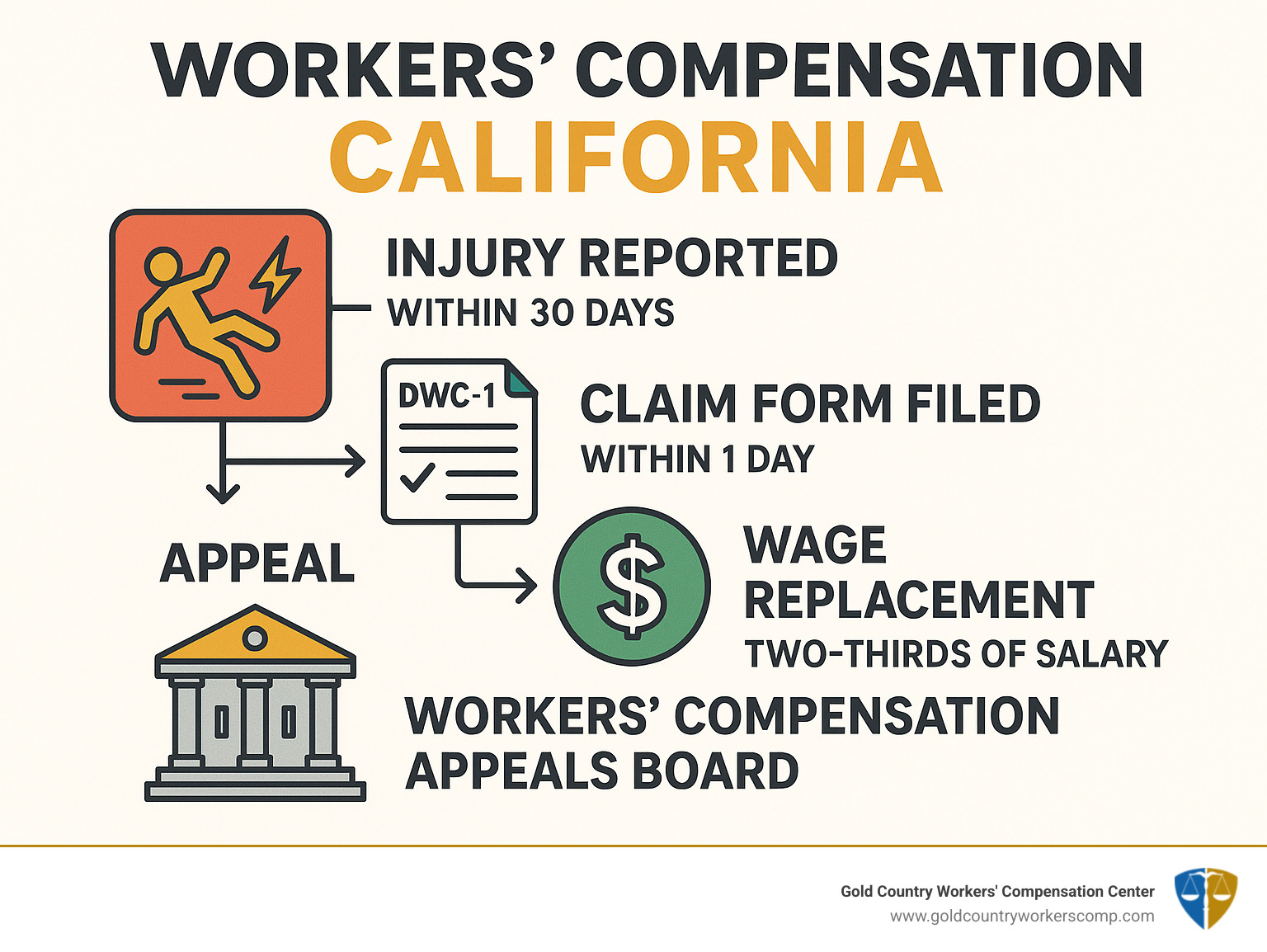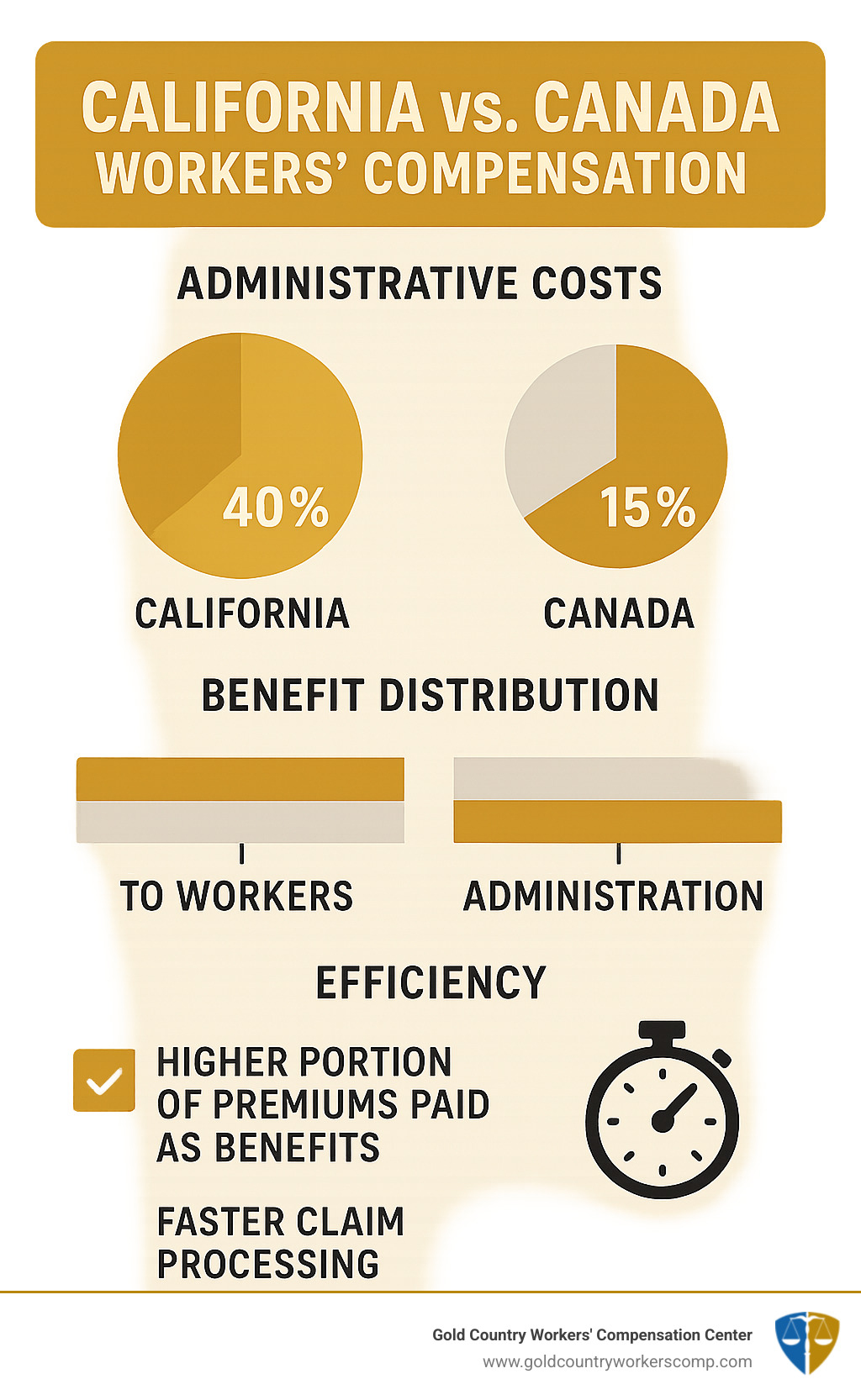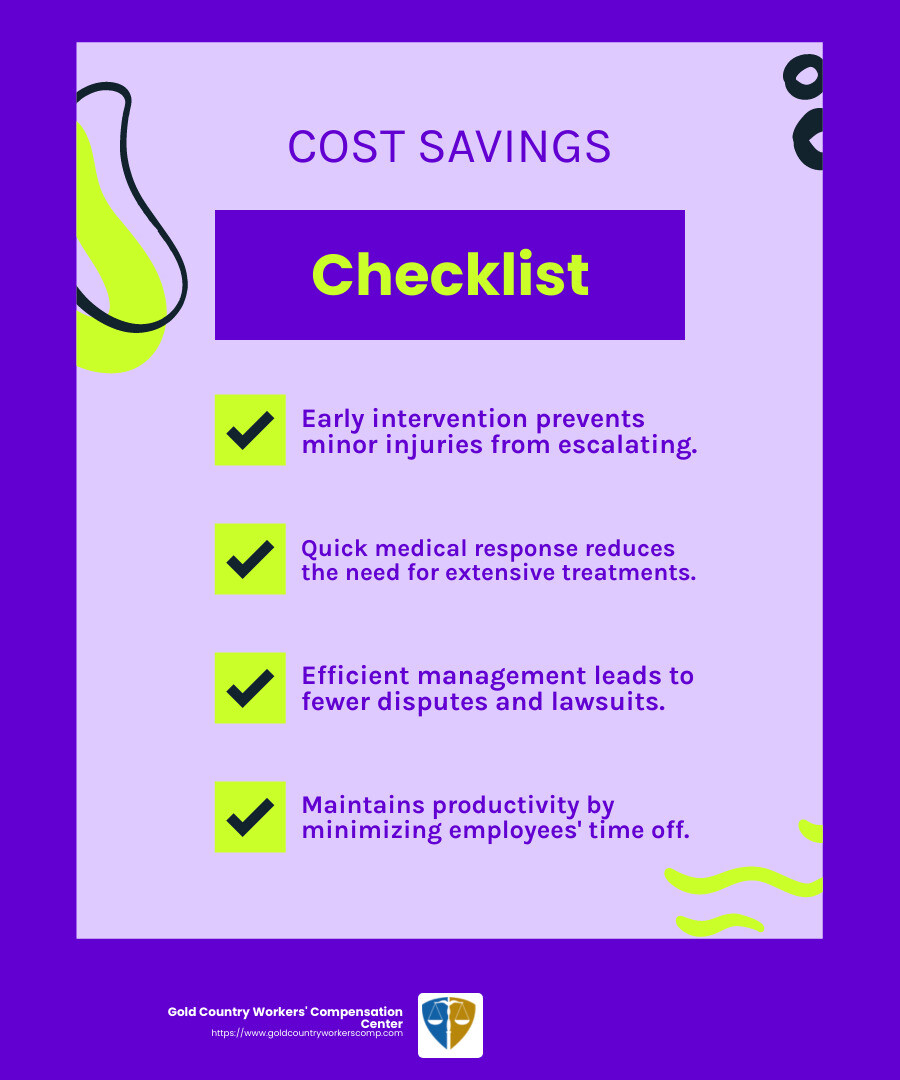Why Understanding Workers’ Compensation California Rights Matters
Workers’ compensation california provides critical financial and medical protection for millions of employees across the state. Here’s what you need to know:
Key Workers’ Compensation California Facts:
– All employers with employees must carry workers’ comp insurance or legally self-insure
– No-fault system – benefits available regardless of who caused the injury
– Medical coverage – 100% of treatment costs for work-related injuries
– Wage replacement – Up to two-thirds of your weekly wages while recovering
– 30-day reporting window – You have 30 days to report injuries to your employer
– $10,000 emergency care – Employers must authorize up to $10,000 in treatment immediately
California’s workers’ compensation system protects over 15 million workers and paid out $9.9 billion in benefits as of recent data. The system operates on a no-fault basis, meaning you don’t need to prove your employer was negligent – you simply need to show your injury or illness is work-related.
Early action is critical. Workers who understand the process and act quickly typically receive benefits faster and avoid common pitfalls that can delay or reduce their compensation.

Workers’ compensation california basics:
– affordable workers compensation lawyer
– early intervention workers compensation
– workers comp attorney sacramento
Workers’ Compensation Basics in California
California’s workers’ compensation california system started in 1913 with the Boynton Act, making it one of the oldest worker protection programs in the country.
The system operates on a no-fault principle – you don’t have to prove your employer did something wrong to get benefits. Before this system existed, injured workers had to drag their employers to court and prove negligence, a process that could take years.
Every California business with employees must carry workers’ compensation insurance. Companies can either buy insurance from private carriers or become legally self-insured through the Department of Industrial Relations. For businesses that can’t find coverage elsewhere, the State Compensation Insurance Fund acts as a safety net.
California’s system is expensive to run – administrative costs eat up about 40% of total system expenses, roughly $7.3 billion in bureaucratic overhead. Compare that to Canada’s streamlined system at just 15% administrative costs.
What Is Workers’ Compensation?
Workers’ compensation california is your financial safety net when work goes sideways. It’s a state-required insurance program that covers your medical treatment completely – 100% of costs for everything from emergency room visits to surgery to physical therapy.
The system also provides wage replacement while you’re recovering – typically about two-thirds of your regular weekly pay. If your injury leaves you with permanent limitations, you’ll receive disability benefits based on how much your earning capacity has been affected.
Why California Requires It
The collective liability principle spreads the cost of workplace injuries across all employers, preventing any single business from going bankrupt because of one catastrophic accident.
Security of payment means you get benefits quickly without waiting for lawyers to fight in court for months or years. The system also creates safety incentives – companies with poor safety records pay higher premiums, giving employers financial reasons to invest in safety.
Eligibility, Coverage & Benefits

Workers’ compensation california protects temporary workers, part-time staff, and even some independent contractors who get hurt on the job.
Workplace injuries fall into two main categories: dramatic single-event trauma like slipping on wet floors or getting caught in machinery, and cumulative trauma that builds up over time, like carpal tunnel syndrome or back problems from repetitive lifting.
Occupational diseases from workplace exposure to chemicals, dust, or other hazards are also covered. When you’re eligible, benefits include temporary disability payments, permanent disability compensation, Supplemental Job Displacement Benefit (SJDB) vouchers for retraining, and death benefits for families.
Labor Code Section 132a makes it illegal for employers to retaliate against you for filing a claim.
For more details on approved injuries, check out our guide on Common Workers Comp Claims.
What Injuries Does Workers’ Compensation California Cover?
Workers’ compensation california covers obvious injuries like falls from ladders, cuts from machinery, and burns from equipment. But it also recognizes repetitive strain injuries from typing, lifting, or performing the same motion thousands of times.
Mental health coverage includes PTSD from workplace trauma, depression from toxic work environments, and anxiety from job-related stress. Public safety workers get special treatment through presumptive injury statutes – if you’re a police officer, firefighter, or paramedic who develops conditions like heart disease or cancer, the law presumes these came from your job.
Occupational diseases from long-term workplace exposures like hearing loss from noise, lung problems from dust or chemicals, and skin conditions from irritating substances all qualify, even if they don’t show up until years later.
How Are Benefits Calculated Under Workers’ Compensation California?
Workers’ compensation california provides two-thirds of your average weekly wage while you’re unable to work. For 2025, the maximum weekly payment is $1,680.29, up from $1,619.15 the previous year. The minimum weekly rate increased to over $250.
These annual cost-of-living adjustments (COLA) help your benefits keep pace with inflation. Workers’ compensation benefits are generally tax-free, so two-thirds of your gross pay might feel closer to your normal take-home amount.
The calculation looks at your earnings history over the year before your injury, including overtime, bonuses, and other regular compensation to ensure your benefits reflect what you were really making.
Navigating Workers’ Compensation California: Step-by-Step Claims Process
The moment you get hurt, your clock starts ticking. California gives you 30 days to report your injury to your supervisor, but don’t wait – the sooner you report, the faster you’ll start receiving benefits.
Your employer must hand you a DWC-1 claim form within one working day of learning about your injury. They must authorize medical treatment within one working day and approve up to $10,000 in treatment right away while investigating your case.
If treatment gets denied, you can appeal through Independent Medical Review (IMR). For disagreements about your medical condition, you can request a Qualified Medical Evaluator (QME) or Agreed Medical Evaluator (AME) for an independent opinion.
For step-by-step guidance, check out our detailed guide on How to Make a Workers Comp Claim in California.
Employee Action Plan
Report your injury immediately to your supervisor. Get emergency medical care if needed – your health comes before paperwork. Complete and return the DWC-1 form within one working day of receiving it.
Keep detailed records of everything – dates, times, who you talked to, doctors you saw, and treatments received. Follow up promptly with your employer and claims administrator.
You don’t have to wait for claim approval to get emergency medical care.
Employer Responsibilities & Penalties
Employers must carry proper insurance, provide claim forms when needed, and authorize necessary medical treatment promptly. Operating without workers’ compensation insurance is a criminal offense with up to one year in jail and $10,000 in fines. Civil penalties can reach $100,000.
Employers cannot fire, demote, or punish you for filing a workers’ compensation claim and must cooperate throughout the entire claims process.
Medical Treatment & Disability Ratings

California uses the Medical Treatment Utilization Schedule (MTUS) to ensure you receive evidence-based care. Most employers work with Medical Provider Networks (MPNs) or Health Care Organizations (HCOs) to coordinate your care.
You’ll work with a Primary Treating Physician (PTP) who coordinates your care and helps determine when you’re ready to return to work. Chiropractic and physical therapy typically cap at 24 visits for injuries after 2004, though exceptions exist for severe cases.
When you reach maximum medical improvement, any lasting effects get rated using California’s permanent disability rating schedule. The system also considers apportionment – figuring out how much of your disability comes from work versus other factors.
The Department of Labor provides extensive research supporting these evidence-based treatment approaches.
Choosing & Changing Doctors
Predesignation is your best option – you can choose your personal physician before any injury occurs, as long as they meet requirements and you notify your employer in writing.
Without predesignation, you can choose from your employer’s Medical Provider Network. After 30 days of treatment, you get a one-time change to another doctor within the network.
You can request evaluation by a Qualified Medical Evaluator (QME) or Agreed Medical Evaluator (AME) for second opinions when you disagree with your doctor’s assessment.
Temporary vs. Permanent Disability Explained
Temporary disability supports you while healing. Temporary Total Disability (TTD) covers you when you can’t work at all. Temporary Partial Disability (TPD) covers wage differences when you can work limited hours.
TTD benefits start after a three-day waiting period, waived if your disability lasts more than 14 days. There’s a 104-week limit for TTD benefits within five years, though severe injuries allow up to 240 weeks.
Permanent disability addresses lasting impairments affecting your earning ability. Higher ratings may qualify you for life pensions rather than fixed-period payments.
For detailed benefit information, see our guide on What You Should Know About Workers Compensation Benefits California.
Disputes, Reforms & Comparative Insights

Compared to Canada’s public workers’ compensation system with just 15% administrative costs, California’s system uses 40% of every premium dollar on administrative expenses. This means only 60 cents of every dollar reaches injured workers.
The Workers’ Compensation Appeals Board (WCAB) handles disputes through mediation and formal hearings. Starting in 2025, most conferences will happen virtually through the CourtCall platform.
Recent legislative changes like Senate Bill 1160 and Assembly Bill 1244 focus on speeding up treatment approvals and cracking down on fraud. The 2025 rate changes brought higher benefit caps while reducing benchmark premiums.
When employers skip workers’ comp insurance illegally, the Uninsured Employers Benefits Trust Fund protects workers. For legislative updates, check this LexisNexis legislative update.
Resolving Claim Disagreements
Information & Assistance (I&A) officers provide free help to injured workers, explaining rights and helping with paperwork. Formal hearings before Workers’ Compensation Administrative Law Judges address complex disputes.
Independent Medical Review (IMR) appeals give you power when insurance companies deny medical treatment. An independent doctor can overturn the insurance company’s decision.
Time is critical with appeals – most have strict deadlines that can permanently block benefits if missed.
Recent Legislative Changes Impacting Workers’ Compensation California
The 2025 legislative session brought significant improvements. Benefit increases were substantial – TTD and PTD rates jumped to $1,680.29 per week, while minimum weekly rates exceeded $250.
Benchmark premium rates decreased from $1.41 to $1.38 per $100 of payroll, lowering costs for employers. Injury reporting requirements were streamlined to encourage prompt claims filing, typically meaning faster benefit access.
Frequently Asked Questions about Workers’ Compensation California
How long do I have to file a claim?
You have one full year from your injury date to file a formal workers’ compensation claim. However, you must notify your employer within 30 days of getting hurt. Miss this deadline, and you could lose your right to benefits entirely.
For injuries that develop over time, the clock starts when you first knew or should have known your condition was work-related.
Don’t wait. Even if you’re unsure your injury is serious enough, report it anyway. You can decide later whether to pursue benefits, but you can’t meet a missed deadline.
Can I choose my own doctor?
Yes, you can choose your own doctor – but California has rules. If you filled out a predesignation form before getting hurt, you can see your personal physician right away.
Most people haven’t predesignated a doctor. In that case, you’ll choose from your employer’s Medical Provider Network (MPN). After treating with an MPN doctor for 30 days, you get one chance to switch to a different network doctor.
You can also request evaluation by a Qualified Medical Evaluator (QME) for second opinions.
What happens if my employer has no insurance?
The Uninsured Employers Benefits Trust Fund (UEBTF) provides the same benefits you would get from regular insurance. You file your claim with this state fund instead of a private insurance company.
Your employer faces serious consequences – criminal fines up to $10,000, jail time up to one year, and civil penalties reaching $100,000 or more.
You might also have the right to sue your uninsured employer directly in regular court. Don’t let an uninsured employer discourage you from seeking benefits – the state protects workers even when employers break the law.
Conclusion
Knowing your workers’ compensation california rights is essential for protecting your family’s financial future. The system offers comprehensive support through medical coverage, wage replacement, and disability benefits, but only works when you understand how to access them properly.
Time matters tremendously. You have just 30 days to report your injury to your employer. Seek medical attention immediately for serious injuries and complete that DWC-1 claim form as soon as your employer provides it. Keep detailed records of every interaction.
Early intervention changes everything. Workers who act quickly and get proper guidance typically receive benefits faster and avoid frustrating delays that can drag cases out for months.
At Gold Country Workers’ Compensation Center, we’ve spent almost 50 years helping people steer California’s complex system. Our approach is simple: get involved early, before problems develop, and never charge for that first consultation. Whether you’re dealing with a construction accident in Roseville, a repetitive strain injury in Nevada City, or any workplace injury across Northern California, we understand what you’re going through.
You don’t have to face this alone. The workers’ compensation system can feel overwhelming, especially when you’re dealing with pain and worry about bills. That’s why we’re here – to handle the legal complexities while you focus on getting better.
Your rights under California law are real and protected, but only if you know how to exercise them. Don’t let confusion prevent you from getting the benefits you’ve earned.
Ready to take the next step? Contact us today for your free consultation. For more information about how we can help, visit More info about California Workers Compensation Lawyer.
Remember: your financial security after a workplace injury depends on the actions you take right now. Act quickly, stay informed, and get the experienced help you need to protect your future.
















